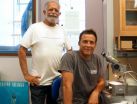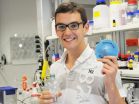(Press-News.org) Irvine, Calif., July 23, 2014 — A therapy combining salmon fibrin injections into the spinal cord and injections of a gene inhibitor into the brain restored voluntary motor function impaired by spinal cord injury, scientists at UC Irvine's Reeve-Irvine Research Center have found.
In a study on rodents, Gail Lewandowski and Oswald Steward achieved this breakthrough by turning back the developmental clock in a molecular pathway critical to the formation of corticospinal tract nerve connections and providing a scaffold so that neuronal axons at the injury site could grow and link up again.
Results appear in the July 23 issue of The Journal of Neuroscience.
The work expands on previous research at UCI. In 2010, Steward helped discover that axons flourish after the deletion of an enzyme called PTEN, which controls a molecular pathway regulating cell growth. PTEN activity is low during early development, allowing cell proliferation. PTEN subsequently turns on, inhibiting this pathway and precluding any ability to regenerate.
Two years later, a UCI team found that salmon fibrin injected into rats with spinal cord injury filled cavities at the injury site, giving axons a framework in which to reconnect and facilitate recovery. Fibrin is a stringy, insoluble protein produced by the blood clotting process and is used as a surgical glue.
"This is a major next step in our effort to identify treatments that restore functional losses suffered by those with spinal cord injury," said Steward, professor of anatomy & neurobiology and director of the Reeve-Irvine Research Center, of the current findings. "Paralysis and loss of function from spinal cord injury has been considered irreversible, but our discovery points the way toward a potential therapy to induce regeneration of nerve connections."
In their study, he and Lewandowski treated rodents with impaired hand movement due to spinal cord injury with a combination of salmon fibrin and a PTEN inhibitor called AAVshPTEN. A separate group of rodents got only AAVshPTEN.
The researchers saw that rats receiving the inhibitor alone did not exhibit improved motor function, whereas those given AAVshPTEN and salmon fibrin recovered forelimb use involving reaching and grasping.
"The data suggest that the combination of PTEN deletion and salmon fibrin injection into the lesion can significantly enhance motor skills by enabling regenerative growth of corticospinal tract axons," Steward said.
According to the Christopher & Dana Reeve Foundation, about 2 percent of Americans have some form of paralysis resulting from spinal cord injury, due primarily to the interruption of connections between the brain and spinal cord.
An injury the size of a grape can lead to complete loss of function below the site of occurrence. For example, an injury to the neck can cause paralysis of the arms and legs, an absence of sensation below the shoulders, bladder and bowel incontinence, sexual dysfunction, and secondary health risks such as susceptibility to urinary tract infections, pressure sores and blood clots due to an inability to move the legs.
Steward said the next objective is to learn how long after injury the combination treatment can be effectively administered. "It would be a huge step if it could be delivered in the chronic period weeks and months after an injury, but we need to determine this before we can engage in clinical trials," he said.
INFORMATION:
Lewandowski is a project scientist in the Reeve-Irvine Research Center. The study received support from the National Institutes of Health (grant R01 NS047718) and donations from Cure Medical and Unite 2 Fight Paralysis.
About the Reeve-Irvine Research Center: The mission of the Reeve-Irvine Research Center is to find new treatments for spinal cord injury through the collaborative research and educational efforts of prominent scientists and clinicians both at UCI and around the world. For more information, visit http://www.reeve.uci.edu.
About the University of California, Irvine: Founded in 1965, UCI is ranked first among U.S. universities under 50 years old by the London-based Times Higher Education and is the youngest member of the prestigious Association of American Universities. The campus has produced three Nobel laureates and is known for its academic achievement, premier research, innovation and anteater mascot. Currently under the leadership of interim Chancellor Howard Gillman, UCI has more than 28,000 students and offers 192 degree programs. Located in one of the world's safest and most economically vibrant communities, it's Orange County's second-largest employer, contributing $4.3 billion annually to the local economy.
Media access: UC Irvine maintains an online directory of faculty available as experts to the media at today.uci.edu/resources/experts.php. Radio programs/stations may, for a fee, use an on-campus ISDN line to interview UC Irvine faculty and experts, subject to availability and university approval. For more UC Irvine news, visit news.uci.edu. Additional resources for journalists may be found at communications.uci.edu/for-journalists.
Gene inhibitor, salmon fibrin restore function lost in spinal cord injury
UCI Reeve-Irvine researchers identify novel combination treatment
2014-07-23
ELSE PRESS RELEASES FROM THIS DATE:
Fires in the Northern Territories July 2014
2014-07-23
Environment Canada has issued a high health risk warning for Yellowknife and surrounding area because of heavy smoke in the region due to forest fires. In the image taken by the Aqua satellite, the smoke is drifting eastward along normal wind patterns. Fire is an obvious health hazard, but the smoke that comes from fires is not quite so obvious and its effects are insidious.
The smoke released by any type of fire (forest, brush, crop, structure, tires, waste or wood burning) is a mixture of particles and chemicals produced by incomplete burning of carbon-containing ...
Study links enzyme to autistic behaviors
2014-07-23
RIVERSIDE, Calif. — Fragile X syndrome (FXS) is a genetic disorder that causes obsessive-compulsive and repetitive behaviors, and other behaviors on the autistic spectrum, as well as cognitive deficits. It is the most common inherited cause of mental impairment and the most common cause of autism.
Now biomedical scientists at the University of California, Riverside have published a study that sheds light on the cause of autistic behaviors in FXS. Appearing online today (July 23) in the Journal of Neuroscience, and highlighted also on the cover in this week's print issue ...
This week from AGU: New Oso report, rockfall in Yosemite, and earthquake models
2014-07-23
From AGU's blogs: Oso disaster had its roots in earlier landslides
A research team tasked with being some of the first scientists and engineers to evaluate extreme events has issued its findings on disastrous Oso, Washington, landslide. The report studies the conditions and causes related to the March 22 mudslide that killed 43 people and destroyed the Steelhead Haven neighborhood in Oso, Washington. The team from the Geotechnical Extreme Events Reconnaissance (GEER) Association, funded by the National Science Foundation, determined that intense rainfall in the three ...
York University researchers use bird 'backpacks' to put wood thrushes migration on the map
2014-07-23
TORONTO, July 23, 2014 – Migratory songbirds are disappearing, and though conservationists are examining several possible reasons such as climate change, loss of habitat, acid rain and light pollution, a key piece of the puzzle has remained missing: where do these birds go once they leave their breeding sites, and what threats may they be encountering along the way?
To answer this question, a team of researchers out of York University have created the first ever migratory connectivity map produced for a songbird, using tracking from both breeding and winter sites. They ...
Diseases of another kind
2014-07-23
The drought that has the entire country in its grip is affecting more than the color of people's lawns. It may also be responsible for the proliferation of a heat-loving amoeba commonly found in warm freshwater bodies, such as lakes, rivers and hot springs, which the drought has made warmer than usual this year.
A 9-year-old Kansas girl recently died of an infection caused by this parasite after swimming in several area lakes. The amoeba enters the body through the nose of an individual and travels to the brain. Nose plugs can lower the odds of this rare but fatal pathogen ...
ETH student develops filter for clean water around the world
2014-07-23
Roughly 780 million people around the world have no access to clean drinking water. According to the World Health Organization (WHO), 3.4 million people die from water-related diseases every year. ETH student Jeremy Nussbaumer set himself the goal of making a contribution to solving this problem. Working with researchers from a group led by Wendelin Stark, head of the Functional Materials Laboratory, the 23-year-old spent a year researching a membrane filter and developing a prototype.
"What makes our DrinkPure filter unique is that you can screw it on to virtually any ...
Ketamine can be a wonder drug for ER patients and their physicians
2014-07-23
WASHINGTON -- For critically ill patients arriving at the emergency department, the drug ketamine can safely provide analgesia, sedation and amnesia for rapid, life-saving intubation, despite decades-old studies that suggested it raised intracranial pressure. The results of a systematic review of 10 recent studies of what many emergency physicians regard as a "wonder drug" are published online in Annals of Emergency Medicine "The Effect of Ketamine on Intracranial and Cerebral Perfusion Pressure and Health Outcomes: A Systematic Review."
"Apprehension for many years ...
Climate change and the soil
2014-07-23
Washington, DC -- The planet's soil releases about 60 billion tons of carbon into the atmosphere each year, which is far more than that released by burning fossil fuels. This happens through a process called soil respiration. This enormous release of carbon is balanced by carbon coming into the soil system from falling leaves and other plant matter, as well as by the underground activities of plant roots.
Short-term warming studies have documented that rising temperatures increase the rate of soil respiration. As a result, scientists have worried that global warming ...
AGU: Voyager spacecraft might not have reached interstellar space
2014-07-23
WASHINGTON, D.C. -- In 2012, the Voyager mission team announced that the Voyager 1 spacecraft had passed into interstellar space, traveling further from Earth than any other manmade object.
But, in the nearly two years since that historic announcement, and despite subsequent observations backing it up, uncertainty about whether Voyager 1 really crossed the threshold continues. There are some scientists who say that the spacecraft is still within the heliosphere – the region of space dominated by the Sun and its wind of energetic particles – and has not yet reached the ...
Wide-faced men negotiate nearly $2,200 larger signing bonus
2014-07-23
RIVERSIDE, Calif. -- Having a wider face helps men when they negotiate for themselves but hurts them when they are negotiating in a situation that requires compromise. Additionally, men who are more attractive are better collaborators compared to less attractive men.
Those are among the findings outlined in a just published paper co-authored by Michael P. Haselhuhn and Elaine M. Wong, assistant professors of management at the University of California, Riverside's School of Business Administration. The paper describes four negotiation simulations set up by the authors ...
LAST 30 PRESS RELEASES:
Personalised “cocktails” of antibiotics, probiotics and prebiotics hold great promise in treating a common form of irritable bowel syndrome, pilot study finds
Experts developing immune-enhancing therapies to target tuberculosis
Making transfusion-transmitted malaria in Europe a thing of the past
Experts developing way to harness Nobel Prize winning CRISPR technology to deal with antimicrobial resistance (AMR)
CRISPR is promising to tackle antimicrobial resistance, but remember bacteria can fight back
Ancient Maya blessed their ballcourts
Curran named Fellow of SAE, ASME
Computer scientists unveil novel attacks on cybersecurity
Florida International University graduate student selected for inaugural IDEA2 public policy fellowship
Gene linked to epilepsy, autism decoded in new study
OHSU study finds big jump in addiction treatment at community health clinics
Location, location, location
Getting dynamic information from static snapshots
Food insecurity is significant among inhabitants of the region affected by the Belo Monte dam in Brazil
The Society of Thoracic Surgeons launches new valve surgery risk calculators
Component of keto diet plus immunotherapy may reduce prostate cancer
New circuit boards can be repeatedly recycled
Blood test finds knee osteoarthritis up to eight years before it appears on x-rays
April research news from the Ecological Society of America
Antimicrobial resistance crisis: “Antibiotics are not magic bullets”
Florida dolphin found with highly pathogenic avian flu: Report
Barcodes expand range of high-resolution sensor
DOE Under Secretary for Science and Innovation visits Jefferson Lab
Research expo highlights student and faculty creativity
Imaging technique shows new details of peptide structures
MD Anderson and RUSH unveil RUSH MD Anderson Cancer Center
Tomography-based digital twins of Nd-Fe-b magnets
People with rare longevity mutation may also be protected from cardiovascular disease
Mobile device location data is already used by private companies, so why not for studying human-wildlife interactions, scientists ask
Test reveals mice think like babies
[Press-News.org] Gene inhibitor, salmon fibrin restore function lost in spinal cord injuryUCI Reeve-Irvine researchers identify novel combination treatment





